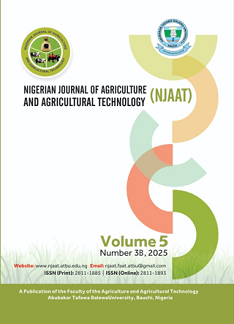ANALYSIS OF AWARENESS AND ACCESSIBILITY OF INFORMATION AND COMMUNICATION TECHNOLOGIES (ICTs) AMONG CROP FARMERS IN KANO STATE, NIGERIA
Keywords:
Awareness, Accessibility, Information, Communication, Technologies, FarmersAbstract
The study examined the awareness and accessibility of information and communication technologies (ICTs) among crop farmers in Kano State, Nigeria. A multi-stage sampling procedure was used to select (162) respondents. Data were collected using a well-structured questionnaire and analyzed with descriptive and inferential statistics. The results showed that (56.2%) of respondents were rice farmers, while (15.4%), (14.8%), and (13.6%) were millet, sorghum, and maize farmers, respectively. The findings revealed that (35.8%) of respondents were aged (41–50) years, with the majority (90.7%) being male and married (92.6%), and having an average household size of 11 members. Additionally, (30.3%) had completed secondary education, and 63.6% belonged to cooperative societies, with an average income of ( ₦72,143.84). Regarding awareness, mobile phones (100%) and radios (96.3%) were the most recognized ICT components, indicating widespread awareness among crop farmers. In terms of accessibility, mobile phones (96.3%), radios (92.6%), and televisions (67.9%) were highly accessible. Furthermore, in utilization, farmers predominantly used mobile phones (93.8%), radios (88.3%), and televisions (61.7%). Logistic regression analysis indicated that household size, education level, farming experience, and cooperative membership significantly influenced ICT awareness and accessibility at p≤0.05, p≤0.01, p≤0.05, and p≤0.05 levels, respectively. The major constraint identified was inadequate skills in using ICTs (98.8%). Despite this limitation, most respondents reported utilizing ICT tools and acknowledged their potential to improve access to agricultural information. The study concludes that mobile phones, radios, and televisions are the most recognized, accessible, and utilized ICT components among crop farmers, with mobile phones leading in all three categories (100% awareness, 96.3% accessibility, 93.8% utilization). It recommends that farmers actively participate in cooperative societies to leverage shared resources, strengthen support networks, and advocate for policies promoting ICT acceptance.
Downloads
Downloads
Published
How to Cite
Issue
Section
License
Copyright (c) 2025 Nigerian Journal of Agriculture and Agricultural Technology

This work is licensed under a Creative Commons Attribution-NonCommercial-ShareAlike 4.0 International License.
This work is licensed under a CC Attribution-NonCommercial-ShareAlike 4.0



